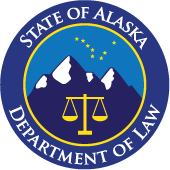Press Release
State Asserts Ownership of Multiple R.S. 2477 Rights-of-Way in the Chicken Area
March 20, 2013
Juneau, Alaska – Today, the State of Alaska filed suit against the United States and others, asserting ownership of multiple R.S. 2477 rights-of-way in the Chicken, Alaska area. This case seeks to address important issues of federal overreach and protection of State sovereignty concerning management and control of important State property interests.
"Litigation is always a last resort, but we will not stand by while the federal government restricts public access to State-owned rights-of-way," Attorney General Michael C. Geraghty said. "In our large State with limited connectivity between communities and resources, these rights-of-way are of vital importance."
Revised Statute 2477 (R.S. 2477), contained in section 8 of the Mining Law of 1866, granted states and territories rights-of-way over unreserved federal lands. The law remained in effect until repealed in 1976. Although no new rights-of-way could be established, the 1976 repeal of R.S. 2477 did not extinguish pre-existing rights already created under the revised statute.
A significant number of R.S. 2477 rights-of-way exist in the historic mining area of the Fortymile Region near Chicken, Alaska. Many of these rights-of-way were created not long after gold was first discovered in the area in 1874. The six rights-of-way asserted by the State in this case total approximately 65 miles of roads and trails, and cover a geographic area of approximately 400 square miles. They have long and rich histories, dating back more than one hundred years. At least two of the six rights-of-way were part of the original Valdez to Eagle, All-American route. All of the rights-of-way continue to serve as important access for miners, hunters, trappers, recreationalists and subsistence users.
Despite an obligation to manage federal lands subject to the State’s valid existing rights, including in areas such as Wild and Scenic River Corridors, the federal government has not been doing so in many instances. Specifically, in this case, the Bureau of Land Management (BLM) has failed to recognize the State's right to any of the rights-of-way asserted in the complaint. BLM has also sought to impose significant management restrictions on use of the rights-of-way. Examples of restrictions imposed on some of the miners using these rights-of-way include:
- Obtaining and paying thousands of dollars for environmental assessments and permits before using the State-owned rights-of-way;
- Obtaining and posting bonds prior to using the State-owned trails;
- Erecting a gate preventing use by the public;
- Notifying the BLM at least five business days before using the trail and requiring a BLM employee to accompany the user on the first spring and summer moves along the right-of-way; and
- Limiting travel to only a few trips per year.
In its recently proposed Eastern Interior Draft Resource Management Plan and Environmental Assessment, BLM has also sought to further limit and, in some cases, eliminate the public’s motorized use of these State-owned rights-of-way.
“This case is an important step in countering federal overreach with regard to State-owned property interests and in protecting the livelihoods of our residents,” Governor Sean Parnell said.
In addition to the federal government, numerous private property owners are also named in the case. While the federal government owned the property at the time these rights-of-way were created, some of the land at issue has since been conveyed to private parties, or private parties now possess an interest in the lands. One instance of this is where a private party holds state or federal mining claims. Due to the fact that the case is a quiet title action, the State has sought to name as defendants all persons and entities whose property interests might be affected by a court determination involving the rights-of-way. This includes many of the miners in the area whose claims are crossed by the rights-of-way. Despite technically being named as defendants, the vast majority of the defendants who have been named are supportive of the State’s actions in seeking to preserve their access rights.
For more information, contact Assistant Attorney General Z. Kent Sullivan at (907) 465-3600.
# # #
Department Media Contacts: Communications Director Patty Sullivan at patty.sullivan@alaska.gov or (907) 269-6368. Information Officer Sam Curtis at sam.curtis@alaska.gov or (907) 269-6269.
